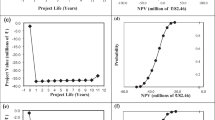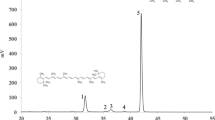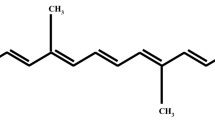Abstract
Present work involves lycopene extraction from tomato using surfactant L62 and separation of the same using cloud point extraction. The maximum extraction efficiency of lycopene from tomatoes (step I) was 54% (w/w) at optimized conditions (dilution distilled water/tomato puree = 1:1, surfactant concentration = 3% (v/v), temperature = 30 ℃, mixing intensity = 110 rpm, time = 50 min), which is significantly higher than the reported methods employing surfactant based systems. Further concentration of lycopene into the coacervate phase was carried out using CPE. The maximum CPE efficiency (step II) of 96% (w/w) was obtained with 3% L62 (v/v) at a temperature of 85 °C (time 30 min). The present process would eliminate the additional step required for back-extraction of lycopene as L62 is used for external applications in humans. Stability test suggest surfactant (L62) shows protective behavior towards lycopene in surfactant phase against degradation/isomerization for greater time at 30 ℃. The techno-economic study suggests that the project is profitable (NPV = 0.78 million of, discounted payback period of 3.7 years). A life cycle assessment study suggests that using surfactant L62 to extract lycopene from tomatoes has a lower environmental impact than using an organic solvent like acetone.







Similar content being viewed by others
Data availability
The dataset generated during and/or analyzed during the current study are available from the corresponding author on reasonable request.
Abbreviations
- µL:
-
Microliter
- CMC:
-
Critical micelle concentration
- COL:
-
Labor of cost
- COM:
-
Cost of manufacturing
- CP:
-
Coacervate phase
- CPE:
-
Cloud point extraction
- CRM:
-
Cost raw material
- CUL:
-
Cost of utility
- DCFROR:
-
Discounted Cash Flow Rate of Return Data
- DP:
-
Dilute phase
- DPBP:
-
Discounted Payback Period
- Eqs:
-
Equation
- g/g:
-
Gram/gram
- g:
-
Gram
- h:
-
Hour
- kWh:
-
Kilo watt hour
- HLB:
-
Hydrophobic and lipophilic balance
- MC:
-
Monte Carlo
- mg:
-
Milligram
- mL:
-
Milliliter
- mM:
-
Milimolar
- nm:
-
Nanometer
- NPV:
-
Net present value
- PBP:
-
Payback Period Data
- PEO-PPO-PEO:
-
Polyethylene oxide polypropylene oxide polyethylene oxide
- R2 :
-
Regression coefficient
- ROROI:
-
Rate of Return on Investment Data
- Rpm:
-
Revolution per minute
- UV:
-
Ultra violet
- UV-VIS:
-
Ultra violet–visible
- v/v:
-
Volume per volume
- ACP:
-
Acidification potential
- EU:
-
Eutrophication potential
- GWP:
-
Global warming potential
- PO:
-
Photochemical ozone creation potential
References
Gustavsson CCJ, van Otterdijk R (2011) Global food losses and food waste. Food Agric. Organ. United Nations 5. Retrieved from https://www.save-food.org
Tara McKenzie (2017) Almost 90% of edible tomatoes thrown away based on appearance – research. The guardian news website of the year (food waste). Retrieved from https://www.theguardian.com/environment/2017/oct/13/you-say-tomato-retailers-say-waste-research-finds-produce-problem
Kcebas A, Kayveci M (2010) Effect on optimum insulation thickness, cost and saving of storage design temperature in cold storage in Turkey. Energy Educ Sci Technol Part A Energy Sci Res 25:117–127
Hossain MM, Scott IM, Berruti F, Briens C (2018) Application of novel pyrolysis reactor technology to concentrate bio-oil components with antioxidant activity from tobacco, tomato and coffee ground biomass. Waste and Biomass Valorization 9:1607–1617. https://doi.org/10.1007/s12649-017-9943-8
Boge L, Hallstensson K, Ringstad L et al (2019) Cubosomes for topical delivery of the antimicrobial peptide LL-37. Eur J Pharm Biopharm 134:60–67. https://doi.org/10.1016/j.ejpb.2018.11.009
Gosia Wozniacka (2019) Study finds farm-level food waste is much worse than we thought. Civil Eats. Retrieved from https://civileats.com/2019/08/20/study-finds-farm-level-food-waste-is-much-worse-than-we-thought
Anarjan N (2020) Evaluation the effects of ultrasonic parameters on simultaneously extraction and size reduction of lycopene from tomato processing waste. Waste and Biomass Valorization 11:1929–1940. https://doi.org/10.1007/s12649-018-0528-y
Silva YPA (2019) Sustainable approach for lycopene extraction from tomato processing by-product using hydrophobic eutectic solvents 56:1649–1654. https://doi.org/10.1007/s13197-019-03618-8
Michelon M, de Matos de Borba T, da Silva Rafael R et al (2012) Extraction of carotenoids from Phaffia rhodozyma: a comparison between different techniques of cell disruption. Food Sci Biotechnol 21:1–8. https://doi.org/10.1007/s10068-012-0001-9
Strati IF, Gogou E, Oreopoulou V (2015) Enzyme and high pressure assisted extraction of carotenoids from tomato waste. Food Bioprod Process 94:668–674. https://doi.org/10.1016/j.fbp.2014.09.012
Choksi PM, Joshi VY (2007) A review on lycopene - extraction, purification, stability and applications. Int J Food Prop 10:289–298. https://doi.org/10.1080/10942910601052699
Papaioannou EH, Liakopoulou-Kyriakides M, Karabelas AJ (2016) Natural origin lycopene and its “green” downstream processing. Crit Rev Food Sci Nutr 56:686–709. https://doi.org/10.1080/10408398.2013.817381
Amiri-Rigi A, Abbasi S (2016) Microemulsion-based lycopene extraction: effect of surfactants, co-surfactants and pretreatments. Food Chem 197:1002–1007. https://doi.org/10.1016/j.foodchem.2015.11.077
Jazaeri S, Mohammadi A, Kermani AMP et al (2018) Characterization of lycopene hydrocolloidal structure induced by tomato processing. Food Chem 245:958–965. https://doi.org/10.1016/j.foodchem.2017.11.077
Poojary MM, Passamonti P (2015) Extraction of lycopene from tomato processing waste: Kinetics and modelling. Food Chem 173:943–950. https://doi.org/10.1016/j.foodchem.2014.10.127
Deng Y, Zhao S, Yang X et al (2021) Evaluation of extraction technologies of lycopene: hindrance of extraction, effects on isomerization and comparative analysis - a review. Trends Food Sci Technol 115:285–296. https://doi.org/10.1016/j.tifs.2021.06.051
Saini RK, Keum YS (2018) Carotenoid extraction methods: a review of recent developments. Food Chem 240:90–103. https://doi.org/10.1016/j.foodchem.2017.07.099
Uquiche E, Antilaf I, Millao S (2016) Enhancement of pigment extraction from B. braunii pretreated using CO2 rapid depressurization. Brazilian J Microbiol 47:497–505. https://doi.org/10.1016/j.bjm.2016.01.020
Amiri-Rigi A, Abbasi S, Scanlon MG (2016) Enhanced lycopene extraction from tomato industrial waste using microemulsion technique: optimization of enzymatic and ultrasound pre-treatments. Innov Food Sci Emerg Technol 35:160–167. https://doi.org/10.1016/j.ifset.2016.05.004
Papaioannou EH, Karabelas AJ (2012) Lycopene recovery from tomato peel under mild conditions assisted by enzymatic pre-treatment and non-ionic surfactants. Acta Biochim Pol 59:71–74. https://doi.org/10.18388/abp.2012_2174
Amiri-Rigi A, Abbasi S (2019) Extraction of lycopene using a lecithin-based olive oil microemulsion. Food Chem 272:568–573. https://doi.org/10.1016/j.foodchem.2018.08.080
Chatzilazarou A, Katsoyannos E, Lagopoulou M, Tsaknis J (2011) Application of cloud point extraction with the aid of Genapol X-080 in the pre-concentration of lycopene and total. Sci Wiss Ernährung/Nutrition 35:5–13
Leite AC, Ferreira AM, Morais ES et al (2018) Cloud point extraction of chlorophylls from spinach leaves using aqueous solutions of nonionic surfactants. ACS Sustain Chem Eng 6:590–599. https://doi.org/10.1021/acssuschemeng.7b02931
Dhamole PB, Wang Z, Liu Y et al (2012) Extractive fermentation with non-ionic surfactants to enhance butanol production. Biomass Bioenerg 40:112–119. https://doi.org/10.1016/j.biombioe.2012.02.007
Dhamole PB, Mane RG, Feng H (2015) Screening of non-ionic surfactant for enhancing biobutanol production. Appl Biochem Biotechnol 177:1272–1281. https://doi.org/10.1007/s12010-015-1812-y
Raut AN, Dhobe AR, Gedam PS, Dhamole PB (2019) Determination of solubilization isotherm in micelles of non-ionic surfactant L62 for butanol extraction. J Mol Liq 287:110960. https://doi.org/10.1016/j.molliq.2019.110960
Gedam PS, Raut AN, Dhamole PB (2019) Effect of operating conditions and immobilization on butanol enhancement in an extractive fermentation using non-ionic surfactant. Appl Biochem Biotechnol 187:1424–1436. https://doi.org/10.1007/s12010-018-2892-2
Gedam PS, Raut AN, Dhamole PB (2019) Microemulsion extraction of biobutanol from surfactant based-extractive fermentation broth. Chem Eng Process - Process Intensif 146:107691. https://doi.org/10.1016/j.cep.2019.107691
Raut AN, Gedam PS, Dhamole PB (2018) Determination of phase transition temperatures of PEO-PPO-PEO block copolymer L62 in presence of fermentation media components. Fluid Phase Equilib 460:126–134. https://doi.org/10.1016/j.fluid.2017.12.038
Raut AN, Gedam PS, Dhamole PB (2018) Back-extraction of butanol from coacervate phase using Winsor III microemulsion. Process Biochem 70:160–167. https://doi.org/10.1016/j.procbio.2018.04.011
McLain VC (2008) Safety assessment of poloxamers 101, 105, 108, 122, 123, 124, 181, 182, 183, 184, 185, 188, 212, 215, 217, 231, 234, 235, 237, 238, 282, 284, 288, 331, 333, 334, 335, 338, 401, 402, 403, and 407, poloxamer 105 benzoate, and poloxamer 182 dibenzoate as use. Int J Toxicol 27:93–128. https://doi.org/10.1080/10915810802244595
Strati IF, Oreopoulou V (2016) Recovery and isomerization of carotenoids from tomato processing by-products. Waste and Biomass Valorization 7:843–850. https://doi.org/10.1007/s12649-016-9535-z
Alexandridis P, Alan Hatton T (1995) Poly(ethylene oxide)poly(propylene oxide)poly(ethylene oxide) block copolymer surfactants in aqueous solutions and at interfaces: thermodynamics, structure, dynamics, and modeling. Colloids Surfaces A Physicochem Eng Asp 96:1–46. https://doi.org/10.1016/0927-7757(94)03028-X
Fish WW, Perkins-Veazie P, Collins JK (2002) A quantitative assay for lycopene that utilizes reduced volumes of organic solvents. J Food Compos Anal 15:309–317. https://doi.org/10.1006/jfca.2002.1069
Indiamart (2022) Indian manufacturers suppliers exporters directory 22-12-2022. Retrieved from https://my.indiamart.com
Turton R, Bailie RC, Whiting WB, Shaeiwitz JA (2009) Analysis, Design and Synthesis of Chemical Processes. Prentice Hall.
Hoe BC, Arumugam P, Chew IML, Tan J, Ooi CW (2022) Extraction of palm carotene from crude palm oil by solvolytic micellization: economic evaluation and life cycle assessment. Chem Eng Commun. https://doi.org/10.1080/00986445.2022.2047664
Raut S, Jain S, Dhamole P, Agrawal S (2022) WPC manufacturing using thermal -polyelectrolyte precipitation: a product quality and techno-economic assessment. J Food Eng 315:110796. https://doi.org/10.1016/j.jfoodeng.2021.110796
India-steel-price (2023) survey on steel price of India. Statista in Corporation with gleeds February 2023. Retrieved from https://www.statista.com/statistics/1219740/india-steel-price-by-city
MSME Loan (2023) MSME loan interest rates by top banks of India. Bank bazar (MSME loan schemes). Retrieved from https://www.bankbazaar.com/personal-loan/msme-loan.html
Atlas big India (2020) Countries by tomato production. AtlasBig.com. Retrieved from https://www.atlasbig.com/en-in/countries-by-tomato-production
Khanna N, Wadhwa J, Pitroda A et al (2022) Life cycle assessment of environmentally friendly initiatives for sustainable machining: a short review of current knowledge and a case study. Sustain Mater Technol 32:e00413. https://doi.org/10.1016/j.susmat.2022.e00413
Amar-Yuli I, Azulay D, Mishraki T et al (2011) The role of glycerol and phosphatidylcholine in solubilizing and enhancing insulin stability in reverse hexagonal mesophases. J Colloid Interface Sci 364:379–387. https://doi.org/10.1016/j.jcis.2011.05.047
Lee MT, Chen BH (2002) Stability of lycopene during heating and illumination in a model system. Food Chem 78:425–432. https://doi.org/10.1016/S0308-8146(02)00146-2
**anquan S, Shi J, Kakuda Y, Yueming J (2005) Stability of lycopene during food processing and storage. J Med Food 8:413–422. https://doi.org/10.1089/jmf.2005.8.413
Garti N, Yaghmur A, Leser ME et al (2001) Improved oil solubilization in oil/water food grade microemulsions in the presence of polyols and ethanol. J Agric Food Chem 49:2552–2562. https://doi.org/10.1021/jf001390b
Spernath A, Yaghmur A, Aserin A et al (2002) Food-grade microemulsions based on nonionic emulsifiers: media to enhance lycopene solubilization. J Agric Food Chem 50:6917–6922. https://doi.org/10.1021/jf025762n
Ferreira JEM, Rodriguez-Amaya DB (2008) Degradation of lycopene and β-carotene in model systems and in lyophilized guava during ambient storage: Kinetics, structure and matrix effects. JFS C: Food Chem 78(8). https://doi.org/10.1111/j.1750-3841.2008.00919.x
Chen J, Shi J, Xue SJ, Ma Y (2009) Comparison of lycopene stability in water- and oil-based food model systems under thermal- and light-irradiation treatments. LWT - Food Sci Technol 42:740–747. https://doi.org/10.1016/j.lwt.2008.10.002
Kim J, Choi SJ (2020) Improving the stability of lycopene from chemical degradation in model beverage emulsion: Impact of hydrophilic group size of emulsifier and antioxidant polarity. Foods 9. https://doi.org/10.3390/foods9080971
Batrakova EV, Kabanov AV (2008) Pluronic block copolymers: evolution of drug delivery concept from inert nanocarriers to biological response modifiers. J Control Release 130:98–106. https://doi.org/10.1016/j.jconrel.2008.04.013
Acknowledgements
The authors would like to thank Badische Anilin und Soda Fabrik for providing the free samples of the surfactant.
Author information
Authors and Affiliations
Contributions
Rajendra D. Yadav: conceptualization, investigation, methodology, formal analysis, writing original draft, writing- reviewing and editing. Tanuj Khare: investigation, formal analysis, writing original draft. Pradip B. Dhamole: writing- reviewing and editing, investigation, supervision, resources.
Corresponding author
Ethics declarations
Conflict of interest
The authors declare no competing interests.
Additional information
Publisher's note
Springer Nature remains neutral with regard to jurisdictional claims in published maps and institutional affiliations.
Supplementary Information
Below is the link to the electronic supplementary material.
Rights and permissions
Springer Nature or its licensor (e.g. a society or other partner) holds exclusive rights to this article under a publishing agreement with the author(s) or other rightsholder(s); author self-archiving of the accepted manuscript version of this article is solely governed by the terms of such publishing agreement and applicable law.
About this article
Cite this article
Yadav, R.D., Khare, T. & Dhamole, P.B. Process development and techno-economic assessment of lycopene extraction from tomatoes using surfactant. Biomass Conv. Bioref. (2023). https://doi.org/10.1007/s13399-023-04080-5
Received:
Revised:
Accepted:
Published:
DOI: https://doi.org/10.1007/s13399-023-04080-5




